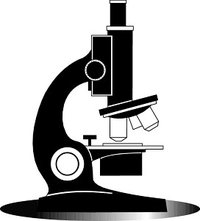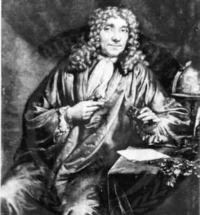Anton van Leeuwenhoek
|
|
Anton van Leeuwenhoek (October 24, 1632 - August 26, 1723) was a tradesman and scientist from Delft, in the Netherlands. He is best known for his contribution to improvement of the microscope and his contributions towards the establishment of cell biology. Using his handcrafted microscope he was the first to observe and describe muscle fibers, bacteria, spermatozoa and blood flow in capillaries (small blood vessels).
His name at birth was Thonis Philipszoon. His letters were signed Antoni van Leeuwenhoek. He was probably known as van Leeuwenhoek from a young age because he was born in a house at the corner of Lion's Gate in Delft. Van Leeuwenhoek translates as "from lion's corner".
Van Leeuwenhoek ground over 500 optical lenses during his lifetime. He also created over 400 different types of microscopes, only nine of which still exist today. His father was a basket maker, and his mother came from a family of brewers. He attended a school in Warmond until he was 16, when he moved away from Delft to get an appreticeship as a linen draper. In 1654, he moved back to Delft and started a drapery business. He used magnifying lens to study the quality of the cloth he sold, which magnified at about 3x power. His microscope was used and improved by Christiaan Huygens for his own investigations into microscopy. He also never gave away the technique that he used for grinding his microscopes. His microscopes were very minute, and were held by the thumb and index finger. Many said that his microscopes were much clearer than the larger ones used by scientists in his time, such as Robert Hooke. He was introduced to microscopy by Huygens to observe the quality of the fabrics that he sold. From there, he grew an insatiable interest for the field. He spent his nights studying everything he could and carefully noted his observations. Unfortunately, he only spoke Dutch while the scientific language of the time was Latin. He wrote to Robert Hooke who knew both Dutch and Latin, and Hooke instantly realised the quality and pertinence of Leeuwenhoek's work. Their correspondence was translated by Hooke into Latin and published in the proceedings of the Royal Society. He kept sending letters to the Royal Society until he died at 91, on August 30, 1732. In his lifetime, Leeuwenhoek was visited by many powerful figures, including Queen Anne of England and Peter the Great, from Russia. Nobody was able to view his best microscopes or recreate microscopes as great as his for over one hundred years after his death.
- "No more pleasant sight has met my eye than this of so many thousands of living creatures in one small drop of water..." - Stated after his discovery of the microscopic world over three centuries ago.
He is thought by some to have been the model for Vermeer's painting The Geographer (Stadelsches Kunstinstitut, Frankfurt-am-Main). Vermeer and van Leeuwenhoek were baptised the same month, in the same church. After Vermeer died, van Leeuwenhoek was appointed curator for the financial affairs of Vermeer's widow. This has led some people to believe that the two must have been friends, even though acting as a curator was part of van Leeuwenhoek's job as a chamberlain of Delft.
Van Leeuwenhoek appeared on an unused design for a 10 guilder note done by M.C. Escher in 1951.
The Dutch Royal Academy presents (every 10 years) the Leeuwenhoek medal to the scientist judged to have made the decade's most significant finding in microbiology. This is regarded by microbiologists as the highest honour in their field.
External links
- Warnar Moll's website on Antoni van Leeuwenhoek (http://www.euronet.nl/users/warnar/leeuwenhoek.html)


